Are you tired of looking older than you feel because of sagging eyelids or under-eye bags? You’re not alone—over 325,000 Americans sought eyelid surgery in 2020, with a remarkable 90% success rate. Laser blepharoplasty offers a solution that’s both effective and minimally invasive, using precision technology to lift and tighten the delicate skin around your eyes.
Whether it’s puffiness, drooping eyelids, or wrinkles, this advanced procedure addresses your concerns with less downtime and faster recovery than traditional methods, helping you look as refreshed as you feel.
What is Laser Blepharoplasty (Eyelid Lift): An Overview
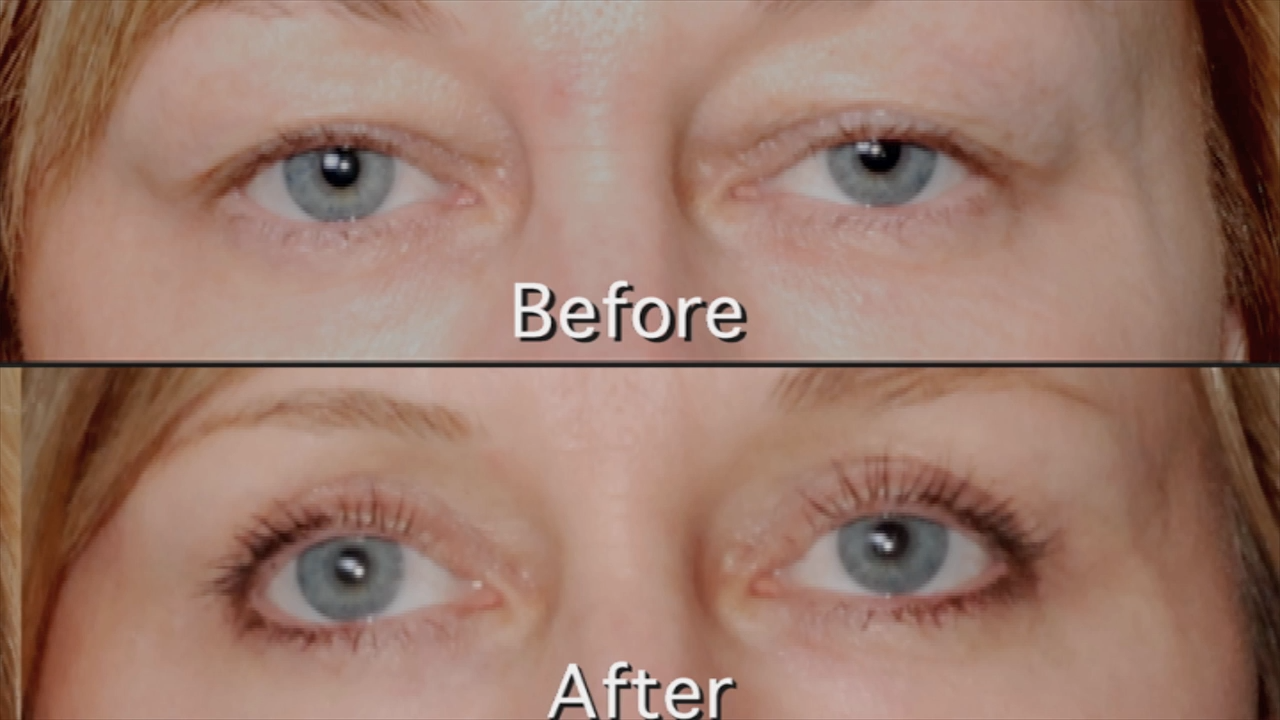
Image by GatewayLaserCenter on YouTube
Laser blepharoplasty is a minimally invasive surgical procedure that uses a specialized laser to remove excess skin and fat from the upper or lower eyelids.
Unlike traditional blepharoplasty, which relies on a scalpel, laser blepharoplasty is a more precise, controlled method that reduces trauma to surrounding tissues.
The laser energy helps tighten the skin, enhance the contours of the eyelid, and promote collagen production, resulting in a smoother, youthful look.
Comparing Laser vs. Traditional Blepharoplasty: Which Technique is Right for You?
When deciding between laser and traditional blepharoplasty, it is important to weigh their differences. While traditional blepharoplasty has long been the go-to option, laser blepharoplasty is rapidly becoming the preferred choice for many patients due to its minimally invasive nature and impressive benefits. Both can deliver excellent results, but each has its unique advantages. Here’s a brief comparison of the both methods:
Aspect | Traditional Blepharoplasty | Laser Blepharoplasty |
Procedure | Surgical incisions to remove excess tissue | Laser vaporization of excess tissue |
Recovery Time | Longer (weeks) | Shorter (days to 1 week) |
Scarring | Visible scarring takes months to fade | Minimal, fades quickly |
Risk of Complications | Higher (infection, poor healing) | Lower (precise, minimal disruption) |
Skin Benefits | None | Improves skin tone, elasticity, and tightness |
Precision | Less precise, larger incisions | More precise, smaller incisions |
Results | Significant results for severe sagging | Natural-looking, smooth results |
Ideal For | Severe eyelid sagging | Mild to moderate sagging, fine lines |
Traditional Blepharoplasty: The Conventional Approach
Traditional blepharoplasty involves making incisions along the natural folds of the eyelids to remove excess skin, fat, and sometimes muscle. This surgical method has been around for decades and is known for providing significant results, especially for patients with more pronounced eyelid sagging.
Drawbacks of Traditional Blepharoplasty:
- Longer Recovery Time: Traditional surgery requires more extensive incisions, leading to a longer healing process. Swelling and bruising may last several weeks, making it difficult to resume normal activities quickly.
- Visible Scarring: While incisions are made in natural creases to minimize scarring, some patients may still experience visible scars that can take months to fade.
- Invasive Procedure: Traditional blepharoplasty is a surgical procedure that involves more significant tissue manipulation, which can increase the risk of complications like infection or poor wound healing.
Laser Blepharoplasty: The Advanced, Minimally Invasive Solution
On the other hand, laser blepharoplasty is a more modern, non-invasive alternative that uses a laser to remove or vaporize excess skin and fat around the eyelids.
The laser’s heat also promotes collagen production, improving skin tone and elasticity for a smoother, more youthful appearance. This technique can be used on upper and lower eyelids to treat issues like sagging, puffiness, and fine lines.
Why Laser Blepharoplasty is the Ultimate Solution:
- Minimal Recovery Time: One of the standout benefits of laser blepharoplasty is the significantly shorter recovery time. With smaller incisions and less tissue disruption, patients can often return to their daily activities within a few days to a week.
- Fewer Risks and Complications: The precision of the laser reduces the risk of scarring, infection, and other complications commonly associated with traditional surgery. Because the laser seals blood vessels as it works, there’s less bleeding during the procedure.
- Non-Surgical Precision: Laser treatment allows for greater accuracy and precision. The laser can target tissue with minimal disruption, leaving surrounding areas unharmed. This is particularly beneficial for delicate areas like the eyelids.
- Improved Skin Tone and Tightening: Beyond removing excess fat and skin, the laser’s heat stimulates collagen production, which results in firmer, smoother skin over time. This additional benefit makes laser blepharoplasty a more comprehensive solution, enhancing the overall appearance of the eyes.
- Minimal Scarring: Since laser blepharoplasty involves smaller incisions, scarring is usually minimal and tends to fade quickly. The laser’s precision also allows for a more discreet treatment, as the incisions are often smaller and more precise than those made during traditional surgery.
Why Laser Blepharoplasty is the Future of Eyelid Rejuvenation
Laser blepharoplasty represents the future of eyelid rejuvenation because it combines the effectiveness of traditional surgery with the benefits of minimally invasive technology.
The technique is safer and less invasive and provides more natural-looking results by stimulating the skin’s collagen production. It’s ideal for those seeking an efficient, low-risk procedure with a quicker recovery and fewer complications.
Exploring Different Laser Blepharoplasty Techniques
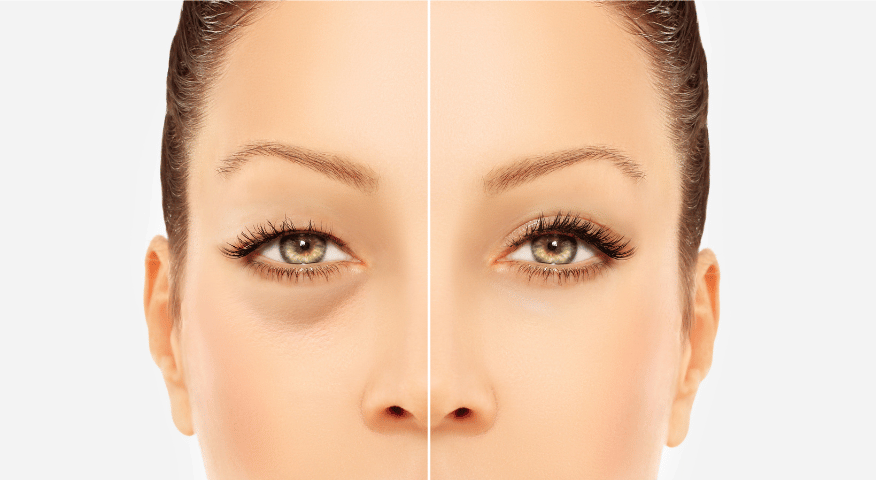
Image by GMint
Not all laser blepharoplasty techniques are the same. Several types of lasers are used in these procedures, each with unique benefits.
Several types of lasers can be used in laser blepharoplasty. Each type has specific advantages depending on the patient’s needs and the eye area being treated. Here’s a breakdown of the most commonly used lasers:
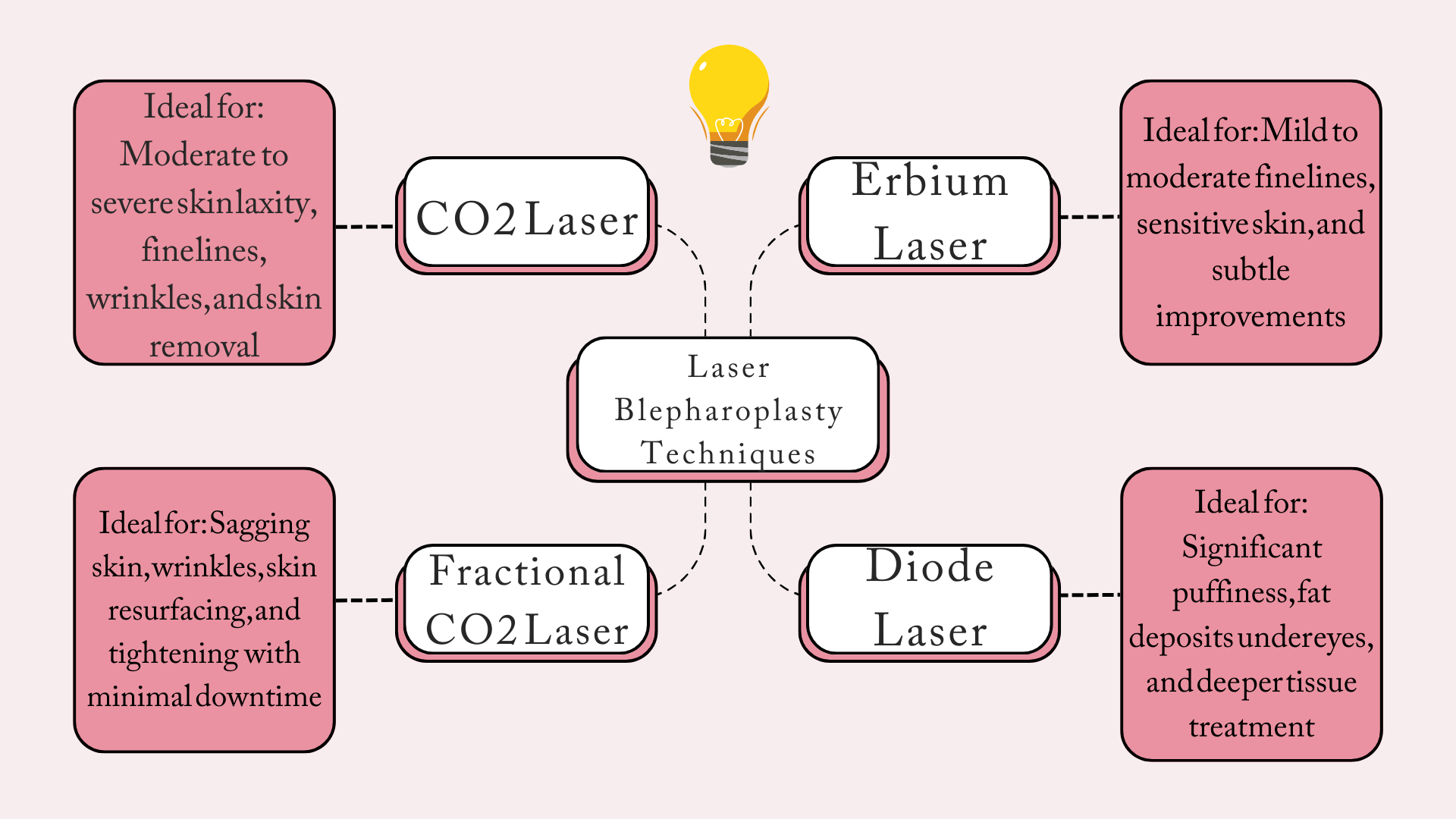
CO2 Laser (Carbon Dioxide Laser)
The CO2 laser is one of the most popular and widely used lasers for laser blepharoplasty. It is highly effective for removing excess skin and fine lines, particularly in more delicate areas like the eyelids. CO2 lasers vaporize the tissue precisely, ensuring minimal bleeding and quicker healing.
- Ideal for:
- Patients with moderate to severe skin laxity, fine lines, or wrinkles and those seeking skin removal and tightening.
- Benefits:
- Effective Skin Tightening: The CO2 laser removes excess skin and stimulates collagen production, helping to tighten and firm the skin over time.
- Precision: This laser is exact, allowing for controlled skin removal, which minimizes the risk of damage to surrounding tissues.
- Versatility: The CO2 laser can treat sagging skin and under-eye bags on the upper and lower eyelids.
Erbium Laser
The Erbium laser is another effective option for laser blepharoplasty, mainly for superficial skin concerns. It is less aggressive than the CO2 laser, making it a good choice for individuals with more sensitive skin or those seeking more subtle improvements.
- Ideal for:
- Individuals with mild to moderate concerns, such as fine lines or early signs of aging around the eyes. It’s an excellent option for those with more delicate skin or looking for a less invasive procedure.
- Benefits:
- Gentler on Skin: The Erbium laser is less invasive and causes less thermal damage than CO2, making it suitable for thinner or more sensitive skin.
- Faster Healing: Because the laser’s energy is more superficial, the recovery time tends to be quicker than that of the CO2 laser.
- Minimal Downtime: Patients typically experience a faster recovery with less swelling and bruising.
Fractional CO2 Laser
The fractional CO2 laser is a more advanced version of the traditional CO2 laser. Unlike the traditional CO2 laser, which treats the entire area simultaneously, the fractional CO2 laser delivers energy in small, targeted columns, leaving surrounding tissue untouched. This method encourages faster healing and minimizes the risk of complications.
- Ideal for:
- Patients who want a less aggressive treatment but still need effective results for sagging skin and wrinkles or seek skin resurfacing and tightening without downtime.
- Benefits:
- Faster Recovery: The fractional nature of the laser allows for quicker recovery, with minimal swelling and bruising compared to full CO2 laser treatments.
- Collagen Stimulation: Like the traditional CO2 laser, the fractional CO2 also stimulates collagen production, improving skin texture and tightness.
- Less Invasive: Because it targets only a fraction of the skin at a time, the procedure is less invasive, benefiting patients concerned about recovery time.
Diode Laser
The Diode laser is a newer option in laser blepharoplasty. It operates at a wavelength different from CO2 or Erbium lasers, which allows it to penetrate deeper into the skin without causing as much surface damage.
- Ideal for:
- Patients with significant puffiness or fat deposits under the eyes and those looking for more profound tissue treatment.
- Benefits:
- Deep Tissue Penetration: The Diode laser can target deeper layers of skin, making it ideal for patients with more pronounced puffiness or fatty deposits under the eyes.
- Minimal Downtime: Like other laser techniques, the Diode laser has a quicker recovery time than traditional blepharoplasty.
- Reduced Risk of Scarring: The precision of the Diode laser allows for smaller incisions and reduced scarring.
Which Laser Blepharoplasty Technique Is Right for You?
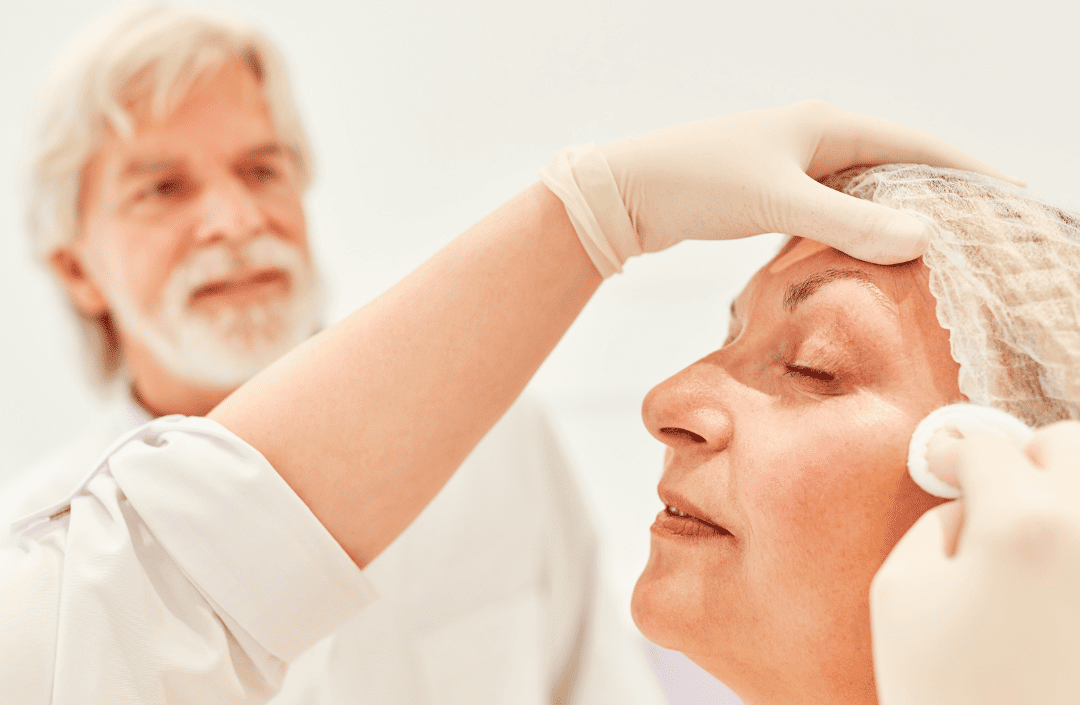
Image by Robert Kneschke
Choosing the correct laser blepharoplasty technique depends on various factors, including your skin type, eyelid concerns’ severity, and desired results. Here are some factors to consider:
- Severity of Concerns: If you have mild to moderate eyelid issues, such as fine lines or minimal sagging, Erbium or fractional CO2 lasers may be the best fit. CO2 or Diode lasers may provide dramatic results for more pronounced skin laxity or under-eye bags.
- Skin Sensitivity: If you have sensitive skin or are concerned about scarring, the Erbium or fractional CO2 lasers may be more suitable due to their gentler approach and quicker healing times.
- Recovery Time: For those looking to return to normal activities as quickly as possible, fractional CO2 or Diode lasers, which offer a faster recovery period, are excellent choices.
- Desired Results: Consider whether you want subtle skin resurfacing or more significant tightening and fat removal. CO2 lasers are ideal for more extensive changes, while Erbium lasers offer more modest improvements.
The Laser Blepharoplasty Procedure: What to Expect
Upper blepharoplasty is focused on the upper eyelids, often treating excess skin, drooping eyelids, and fine lines that contribute to an aged or tired appearance. This procedure is ideal for individuals whose upper eyelids have lost elasticity or have excess skin obstructing vision.
What to Expect During Upper Blepharoplasty:
- Pre-Procedure: Before the procedure, your surgeon will mark the areas to be treated and discuss your aesthetic goals. You may be given a local anesthetic to numb the area, ensuring you’re comfortable throughout the procedure.
- Laser Treatment: The laser is then used to make tiny incisions along the eyelid’s natural crease, allowing access to the underlying skin and fat. The laser vaporizes excess tissue precisely while stimulating collagen production for firmer skin over time. In some cases, excess fat may also be removed or repositioned.
- Post-Procedure: There may be slight swelling or bruising, but recovery is generally quicker than traditional surgery. Most patients can resume normal activities within a few days, with full recovery taking about 1-2 weeks.
Lower Blepharoplasty: Addressing Under-Eye Bags and Puffiness
Lower blepharoplasty targets the lower eyelids, specifically treating concerns like puffiness, dark circles, and sagging skin that forms under the eyes. This area can be particularly challenging due to the thin, delicate skin around the eyes. Laser treatment provides a more precise way to address these issues.
What to Expect During Lower Blepharoplasty:
- Pre-Procedure: The procedure begins with a thorough consultation, during which your surgeon evaluates the extent of the puffiness and sagging. A local anesthetic is applied to numb the area before starting the procedure.
- Laser Treatment: The laser is used to make small incisions along the lower lash line or, in some cases, inside the lower eyelid (transconjunctival approach) to minimize scarring. The laser removes or reshapes excess fat and tightens the skin, reducing puffiness and improving the appearance of fine lines.
- Post-Procedure: Swelling and bruising are common but typically subside faster than with traditional surgery. Most patients experience a noticeable improvement in the under-eye area within a week, and full recovery takes about 1-2 weeks.
Duration of the Procedure: How Long Does a Blepharoplasty Take?
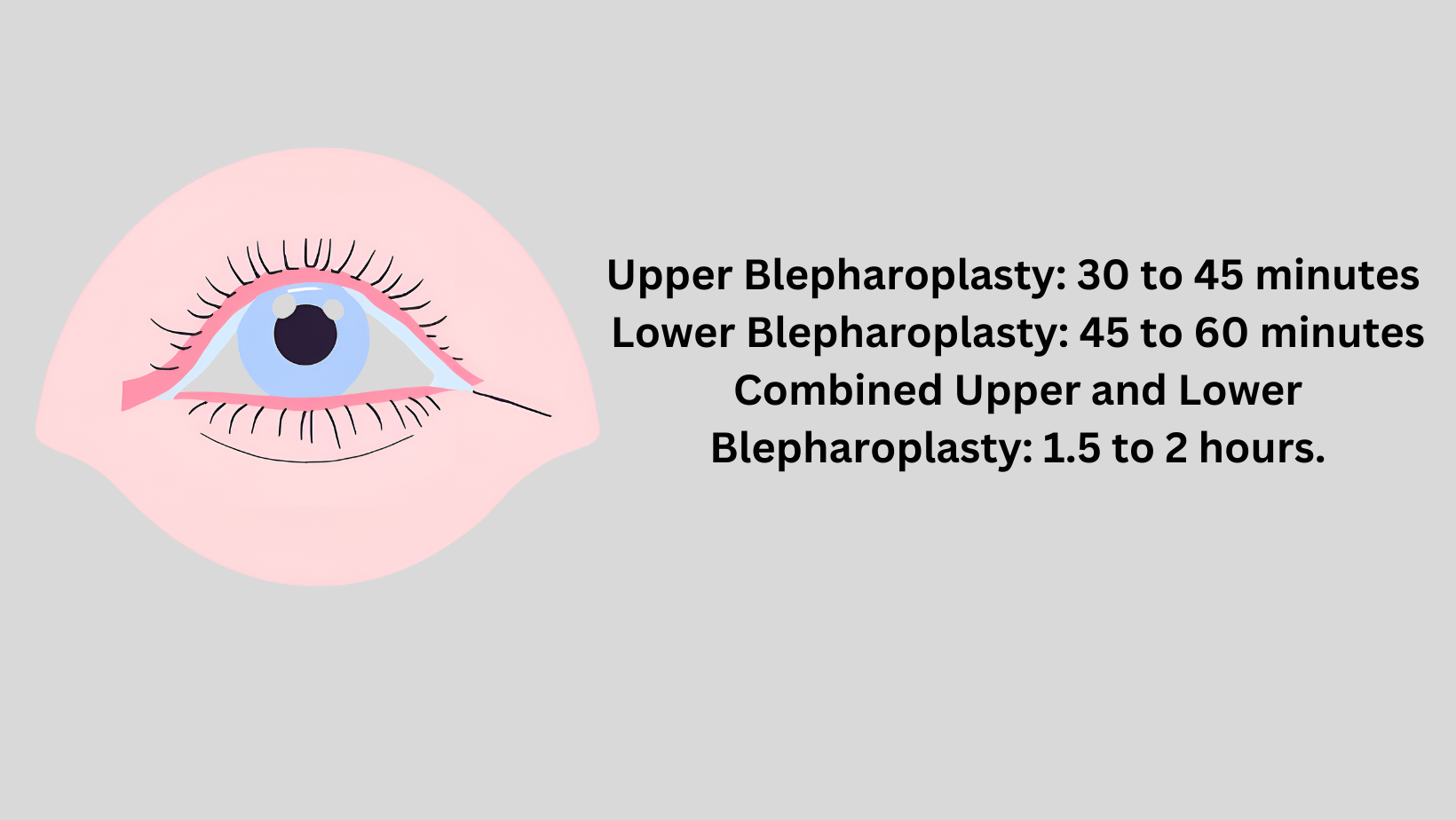
Source: Cleveland clinic
The length of a laser blepharoplasty procedure depends on whether both upper and lower eyelids are treated and the extent of the work required.
- Upper Blepharoplasty Alone typically takes 30 to 45 minutes for both eyes.
- Lower Blepharoplasty Alone usually takes 45 to 60 minutes for both eyes.
- Combined Upper and Lower Blepharoplasty: If both upper and lower eyelids are treated during the same procedure, it can take approximately 1.5 to 2 hours.
What Happens After the Procedure?
Post-procedure care is relatively simple, especially compared to traditional blepharoplasty. Here’s what you can expect:
- Swelling and Bruising: Some swelling and bruising are expected but will diminish quickly, especially with the gentler nature of laser treatment.
- Cold Compresses: Applying cold compresses in the first 24–48 hours can help reduce swelling and discomfort.
- Avoid Strenuous Activities: To allow your body to heal, it’s best to avoid strenuous activities, including exercise and bending over, for about 1–2 weeks.
- Follow-Up: Your surgeon may schedule a follow-up visit to ensure your recovery is on track. You will be given specific aftercare instructions, including using prescribed ointments or avoiding makeup for a few days.
Final Results and Recovery Timeline
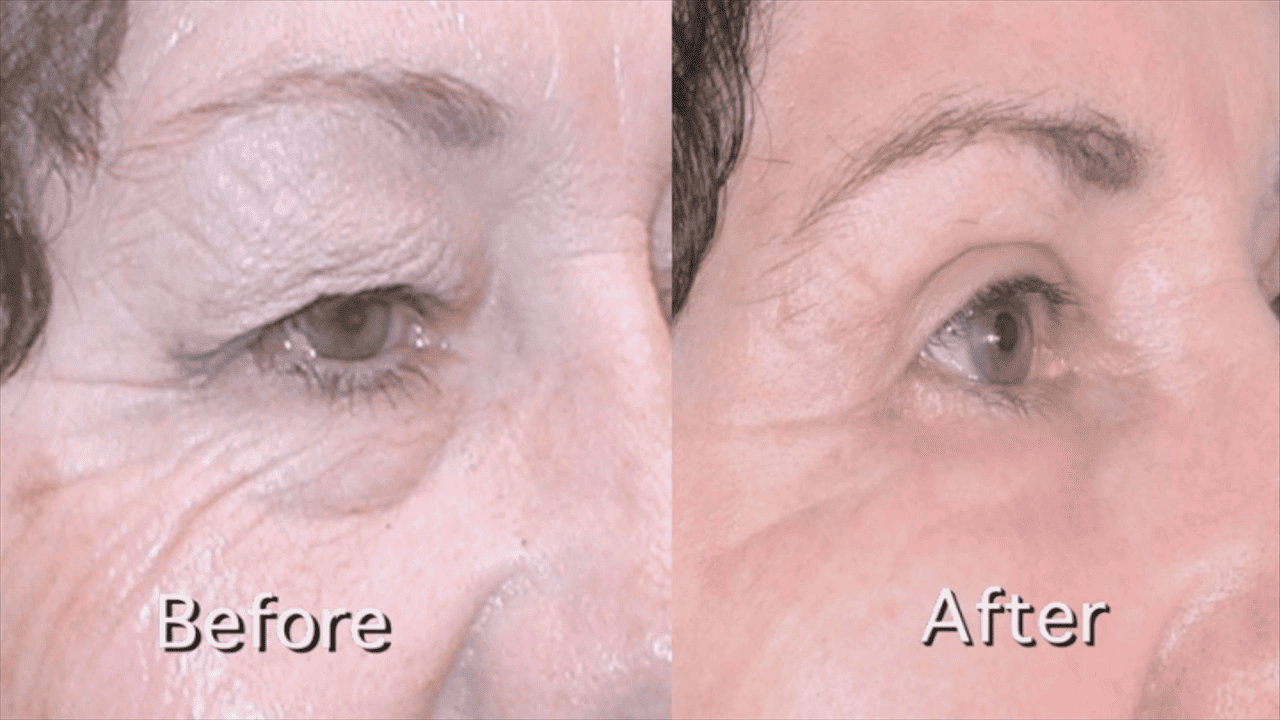
Image by GatewayLaserCenter on YouTube
Most laser blepharoplasty patients notice a refreshed, more youthful appearance within a few days of the procedure. Full results, including reduced swelling and improved skin tightening, typically become apparent in 1–2 weeks. Although recovery time is shorter than traditional surgery, following your surgeon’s aftercare instructions is essential to ensure optimal results.
Laser blepharoplasty offers significant advantages, including reduced downtime, less discomfort, and more precise results than traditional surgical methods. Whether you’re seeking to rejuvenate the upper eyelids, reduce under-eye puffiness, or treat both areas simultaneously, laser blepharoplasty provides a minimally invasive option with impressive outcomes.
Who Can Benefit from Laser Blepharoplasty?
Laser blepharoplasty is ideal for individuals looking to refresh their appearance or improve their eyelids’ function without traditional surgery’s invasiveness. The best candidates for the procedure typically have:
- Those with Mild to Moderate Eyelid Sagging: Laser blepharoplasty is effective for individuals experiencing early signs of eyelid drooping. It offers skin tightening and rejuvenation without the need for invasive surgery.
- Patients with Under-Eye Bags or Puffiness: The procedure reduces puffiness and fat under the eyes by targeting excess fat and tightening the skin. This provides a refreshed, youthful appearance.
- Individuals with Fine Lines or Wrinkles: Laser blepharoplasty stimulates collagen production, smoothing fine lines and wrinkles around the eyes while tightening the skin. It is ideal for those seeking to address crow’s feet or early aging signs.
- Those Looking for Minimal Downtime: One of the main benefits of laser blepharoplasty is its minimal recovery time. The procedure requires smaller incisions, resulting in quicker healing and less discomfort than traditional surgery.
- People with Sensitive Skin or Scarring Concerns: The laser’s precision reduces the risk of scarring, making it an excellent choice for those with sensitive skin or concerns about visible scars.
- Younger Patients Seeking Preventative Care: Younger individuals who notice subtle signs of aging can benefit from laser blepharoplasty, which can address early concerns like mild sagging or puffiness before they worsen.
Understanding the Risks of Laser Blepharoplasty
While laser blepharoplasty is generally safe, like any surgery, it does carry some potential risks. These may include:
- Infection: Although rare, any surgery can lead to infection. If caught early, this can be managed with antibiotics or additional medical treatments.
- Scarring: While laser technology minimizes scarring compared to traditional methods, there’s still a risk of visible scars, mainly if healing doesn’t go as expected. Following post-procedure care instructions helps minimize this risk.
- Dry Eyes: Some patients may experience dryness or irritation after the procedure, as laser blepharoplasty can affect the tear ducts or the eyes’ surface. This can typically be managed with lubricating eye drops.
- Numbness or Sensitivity: Temporary numbness or sensitivity around the eyelids may occur, which usually resolves independently. Rarely, it could be long-lasting if nerve damage occurs.
- Over-correction or Under-correction: There is a risk that too much or too little tissue may be removed, leading to an unnatural appearance or a revision procedure.
- Asymmetry: Although rare, some patients may notice asymmetry after surgery. If necessary, surgeons can correct this with additional treatment.
Cost of Laser Blepharoplasty
The cost of laser blepharoplasty varies depending on the surgeon’s expertise, the extent of the procedure, and the geographic location of the practice. The average price ranges from $3,359 to $3,876 for upper and lower eyelid lifts. Factors that influence the cost include:
- Surgeon’s experience and credentials.
- Location of the procedure.
- Type of laser used.
- Complexity of the surgery (e.g., if fat removal or additional skin tightening is needed).
Do I Need Laser Resurfacing After Blepharoplasty?
Laser resurfacing is not always required after laser blepharoplasty, but it can be beneficial in some cases. It is typically recommended for patients who want to address skin texture, fine lines, or pigmentation issues around the eyelids. Here’s when it might be recommended:
- To Improve Skin Texture and Tone: If the skin around the eyes has significant sun damage, wrinkles, or uneven pigmentation, laser resurfacing can smooth the skin and improve its overall appearance.
- Enhancing Results: Some patients opt for laser resurfacing after blepharoplasty to further tighten the skin and remove any residual wrinkles or fine lines, primarily if the eyelid surgery alone doesn’t provide the desired smoothness level.
- Post-Procedure Skin Healing: In some instances, laser resurfacing is used after the blepharoplasty to encourage healing and minimize scarring by stimulating collagen production.
Laser Blepharoplasty Recovery: What to Expect
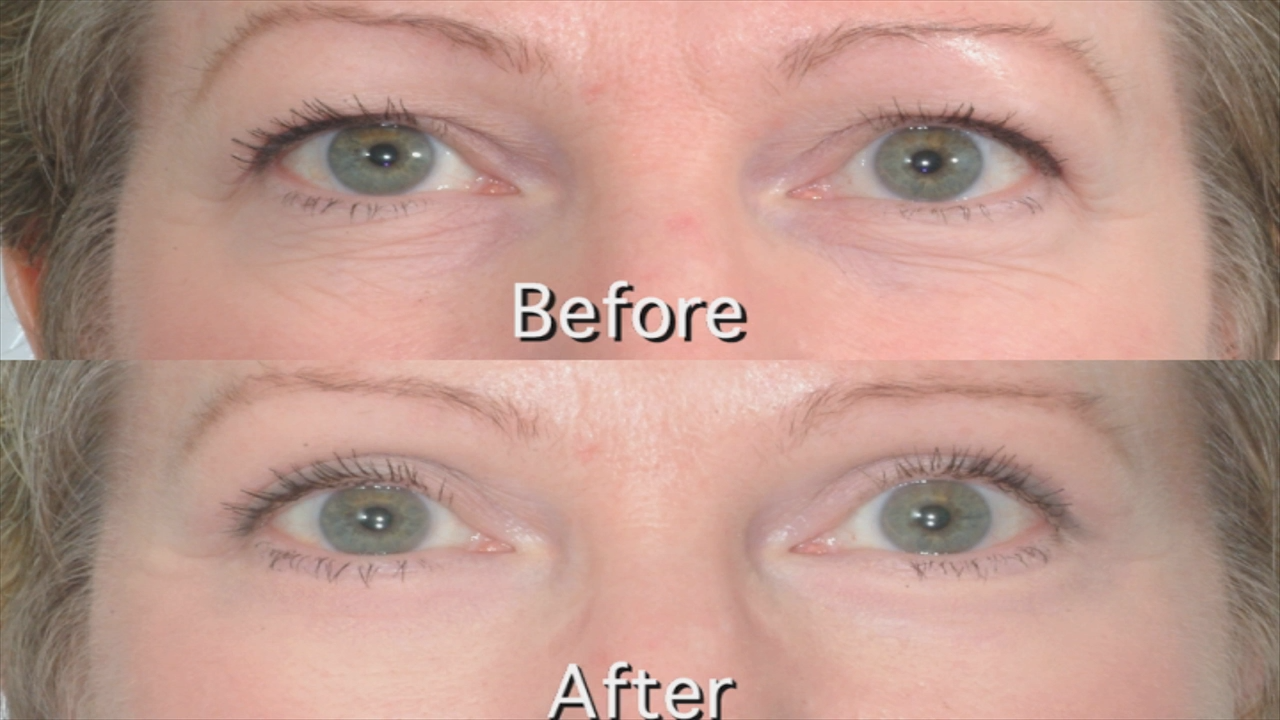
Image by GatewayLaserCenter on YouTube
Recovery from laser blepharoplasty is generally quick, especially compared to traditional surgery. Here’s a timeline of what you can expect:
- First Few Days: Expect some swelling and mild discomfort. Ice packs and prescribed pain relievers can help alleviate these symptoms.
- One Week: Most swelling should subside, and bruising should begin to fade. You should avoid strenuous activity and keep your head elevated while resting.
- Two Weeks: Most patients feel comfortable resuming regular activities, though some residual swelling may persist.
- Full Recovery: Complete recovery takes about 4-6 weeks, and the final results will gradually become visible.
Finding a CO2 Laser Blepharoplasty Specialist Near You
When searching for a qualified CO2 laser blepharoplasty specialist, consider these tips:
- Look for board-certified surgeons with experience in laser surgery.
- Review patient testimonials and before-and-after photos.
- Ensure the surgeon uses advanced, FDA-approved laser technology.
- Schedule consultations with specialists to discuss your goals and determine the best approach for your needs.
If you’re struggling to find the right specialist for your CO2 laser blepharoplasty, Laser Forefront is here to help. With our experienced, board-certified surgeons and cutting-edge, FDA-approved technology, we’re dedicated to delivering safe, precise results tailored to your needs. Don’t leave your appearance to chance—schedule a consultation today and let us guide you toward the youthful, refreshed eyes you deserve.
Does Laser Eyelid Lift Work?
Laser eyelid lift (laser blepharoplasty) addresses common concerns like sagging, puffiness, and wrinkles. The precision of the laser allows for targeted treatment, improving skin tone and texture with minimal discomfort. Many patients see immediate results, with continued improvement as healing progresses.
What Is the Recovery Time for a Laser Eyelid Lift?
Recovery time varies depending on the individual and the extent of the procedure, but most people can return to normal activities within 7 to 10 days. Swelling and bruising typically subside within 1-2 weeks. Full recovery, including the final results, may take up to 6 weeks.
What Is the Best Age for Blepharoplasty?
The best age for blepharoplasty varies depending on individual factors, but most candidates are between 35 and 65. Typically, people start to notice the early signs of aging around the eyes, such as sagging eyelids, puffiness, or wrinkles, in their 30s or 40s. However, some individuals may opt for eyelid surgery earlier if they have hereditary factors that cause early eyelid drooping.
How Long Do the Results of Blepharoplasty Last?
The results of a laser blepharoplasty can last 5 to 7 years, depending on factors like age, lifestyle, and skin condition. While the natural aging process will continue, the improvements in eyelid appearance typically remain long-lasting, helping you look younger for years to come.
This SEO article is well-written and thorough, with several strengths:
- Comprehensive and Informative Content: The article covers all essential aspects of laser blepharoplasty, including benefits, comparison with traditional surgery, different laser techniques, recovery expectations, and post-procedure care. This provides valuable insights for readers considering the procedure.
- Clear Structure: The article is logically organized, starting with a compelling meta description and introduction, followed by detailed sections that break down each element of the procedure. Subheadings like “What to Expect” and “Why Laser Blepharoplasty is the Ultimate Solution” help guide the reader through the content smoothly.
- Keyword Optimization: The article effectively integrates relevant keywords like “laser blepharoplasty,” “eyelid lift,” and “minimally invasive,” making it SEO-friendly without keyword stuffing.
- Engaging and Persuasive Tone: The article addresses reader concerns and questions in a conversational tone, making it engaging. It also emphasizes the advantages of laser blepharoplasty, helping to persuade readers to consider it as an option.
- Use of Visuals: The inclusion of images, tables, and infographics (such as the comparison table) enhances the reader experience by visually breaking up the text and making complex information easier to understand.
- Well-Structured Meta Information: The meta description is concise and relevant, summarizing the article’s content in a way that encourages click-throughs.
Weaknesses:
Lack of Patient Testimonials or Case Studies: Including real patient experiences or success stories could make the article even more relatable and persuasive. Testimonials are a powerful tool for building trust and could help readers feel more confident in considering the procedure.
Conclusion:
Overall, this article is well-rounded, informative, and engaging. It effectively uses SEO techniques, presents comprehensive information on laser blepharoplasty, and addresses the concerns of potential patients with clarity. The strengths of the article lie in its depth of coverage, visual aids, and clear, reader-friendly writing. Incorporating patient testimonials could elevate it even further.

